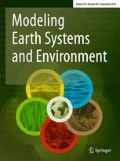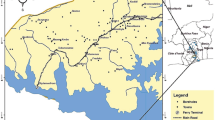Abstract
Agro-stresses on greater Punjab aquifer are rising because of unchecked growths of agriculture. Secondary salinity and pollution loads from non-point sources (NPS) are two environmental concerns of these growths. In order to assess the impacts of NPS pollution on underlying aquifer, a source-pathway-receptor model commonly refered to as DRASTIC is applied in a GIS environment. The model is applied by combining data sets that describe the depth to groundwater, recharge rates, aquifer material, soils composition, topography, vadose zone materials, and hydraulic conductivity. Resultant vulnerability values are scaled into three vulnerability zones based on DRASTIC Vulnerability Index as low, moderate and high vulnerability. A major portion of the study area about 1798 km squares (57.6%) fall under low vulnerability zone, while the porportions of the study area under moderate, and high vulnerabilities are 790 km2 (25.3%), and 551 km2 (17.6%), respectively. The vulnerability of Tehcil Kot Addu is related positively to the recharge rates and agricultural landuse. Results of this study can be used for sustainable agriculture in the study area and other regions having silmilar hydrogeological characteristics.







Similar content being viewed by others
References
Abdullah TO, Ali SS, Al-Ansari NA, Knutsson S (2015) Groundwater vulnerability mapping using lineament density on standard DRASTIC model: case study in Halabja Saidsadiq Basin, Kurdistan Region, Iraq. Engineering 7(10):644–667.
Ahmad F (2013) Land degradation pattern using geo-information technology for Kot Addu, Punjab province, Pakistan. Glob J Human-Soc Sci Res 13(1-B):1–16
Albinet M, Margat J (1970) Groundwater Pollution Vulnerability Mapping. Bulletin du Bureau de Recherches Géologiques et Minières Bull BRGM 2nd Ser 3(4):13–22.
Aller L, Bennett T, Lehr JH, Petty RJ, Hackett G (1987) DRASTIC: a standardized system for evaluating groundwater pollution potential using hydrogeologic settings. Environmental protection agency NWWA/EPA Series EPA-600/ 2-87-035. National Water Well Association, Dublin
Ashraf A, Ahmad Z (2008) Regional groundwater flow modelling of Upper Chaj Doab of Indus Basin, Pakistan using finite element model (Feflow) and geoinformatics. Geophys J Int 173(1):17–24.
Azpurua MA, Ramos KD (2010) A comparison of spatial interpolation methods for estimation of average electromagnetic field magnitude. Prog Electromagn Res 14:135–145.
Childs C (2004) Interpolating surfaces in ArcGIS spatial analyst. ArcUser, July-September, 32–35. http://www.esri.com/news/arcuser/0704/files/interpolating.pdf
Duijvenbooden WV, Waegeningh H (1987) Vulnerability of soil and groundwater to pollutants. Paper represented at the International Conference Noordwijk Aan Zee, The Netherlands
Greenman DW, Swarzenski WV, Bennett GD (1967) Groundwater hydrology of the Punjab, west Pakistan with emphasis on problems caused by canal irrigation. US geology survey water-supply paper
Hanif S (2013) 3D regional groundwater modeling of Thal Doab, Central Indus Basin, Punjab. Dissertation, Bahria University, Islamabad
Hernández-Espriú A, Reyna-Gutiérrez JA, Sánchez-León E, Cabral-Cano E, Carrera-Hernández J, Martínez-Santos P, Colombo D (2014) The DRASTIC-Sg model: an extension to the DRASTIC approach for mapping groundwater vulnerability in aquifers subject to differential land subsidence, with application to Mexico City. Hydrogeol J 22(6):1469–1485
Hussain Y (2014) Hydrogeophysical investigations and GIS vulnerability mapping of Kot Addu. Dissertation, Quaid-i-Azam University, Islamabad
Hussain Y, Ullah SF, Hussain M, Martinez-Carvajal H, Aslam AQ (2016a) Protective capacity assessment of vadose zone material by geo-electrical method: a case study of Pakistan. Int J Geosci 7:716–725
Hussain Y, Ullah SF, Dilawar A, Akhter G, Martinez-Carvajal H, Roig HL (2016b) Assessment of the pollution potential of an aquifer from surface contaminants in a geographic information system: a case study of Pakistan. Geo Chicago 2016. Sustain Resil Geotech Eng. doi:10.1061/9780784480120.063
Hussain Y, Dilawar A, Ullah SF, Akhter G, Martinez-Carvajal H, Hussain MB, Aslam AQ (2016c) Modelling the spatial distribution of arsenic in water and its correlation with public health, Central Indus Basin, Pakistan. J Geosci Environ Prot 4:18–25
Hussain Y, Satgé F, Hussain MB, Martinez-Carvajal H, Bonnet MP, Cárdenas-Soto M, Roig HL, Akhter G (2017a) Performance of CMORPH, TMPA, and PERSIANN rainfall datasets over plain, mountainous, and glacial regions of Pakistan. Theor Appl Climatol 1–14. doi:10.1007/s00704-016-2027-z
Hussain Y, Ullah SF, Akhter G, Aslam AQ (2017b) Groundwater quality evaluation by electrical resistivity method for optimized tubewell site selection in an ago-stressed Thal Doab Aquifer in Pakistan. Model Earth Syst Environ 3(1). doi:10.1007/s40808-017-0282-3
Hussain Y, Ullah SF, Hussain MB, Aslam AQ, Akhter G, Martinez-Carvajal H, Cárdenas-Soto M (2017c) Modelling the vulnerability of groundwater to contamination in an unconfined alluvial aquifer in Pakistan. Environ Earth Sci 76(2). doi:10.1007/s12665-017-6391-5
Lima ML, Zelaya K, Massone H (2011) Groundwater vulnerability assessment combining the DRASTIC and Dyna-Clue Model in the Argentine pampas. Environ Manage 47(5):828–839
Mejia O, Betancur TY, Londoño L (2007) Geostatistics techniques in Bajo Cauca Antioqueño hydrogeology (in Spanish). DYNA 74(152):136–149.
Nickson RT, McArthur JM, Shrestha B, Kyaw-Myint TO, Lowry D (2005) Arsenic and other drinking water quality issues, Muzaffargarh district, Pakistan. Appl Geochem 20(1):55–68
Plymale CL, Angle MP (2002) Groundwater pollution potential of Fulton County, Ohio. Ohio Department of Natural Resources Division of Water, Water Resources Section. Groundwater Pollution Potential, report no 45
Rahman AA (2008) GIS based DRASTIC model for assessing groundwater vulnerability in shallow aquifer in Aligarh, India. Appl Geogr 28(1):32–53
Samake M, Zhonghua T, Hlaing W, M’Bue I, Kanyamanda K (2010) Assessment of groundwater pollution potential of the Datong Basin, Northern China. J Sustain Dev 3(2):140–152
Shekhawat MS, Chundawat DS (2015) Groundwater vulnerability assessment using DRASTIC method approach in and around Keoladev Ghana national park, Rajasthan, India. Int J Curr Res 7(8):19436–19443
Şimşek C (2007) The GIS-integrated surfacial aquifer potential mapping and its importance for aquifer protection, Küçük Menderes Basin/West Turkey. Paper presented at International Congress: River Basin Management, Turkey
Singh A, Srivastav SK, Kumar S, Chakrapani GJ (2015) A modified-DRASTIC model (DRASTICA) for assessment of groundwater vulnerability to pollution in an urbanized environment in Lucknow, India. Environ Earth Sci 74(7):1–16
Author information
Authors and Affiliations
Corresponding author
Rights and permissions
About this article
Cite this article
Hussain, Y., Ullah, S.F., Aslam, A.Q. et al. Vulnerability assessment of an agro-stressed aquifer using a source-pathway-receptor model in GIS. Model. Earth Syst. Environ. 3, 595–604 (2017). https://doi.org/10.1007/s40808-017-0320-1
Received:
Accepted:
Published:
Issue Date:
DOI: https://doi.org/10.1007/s40808-017-0320-1




